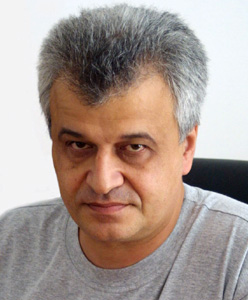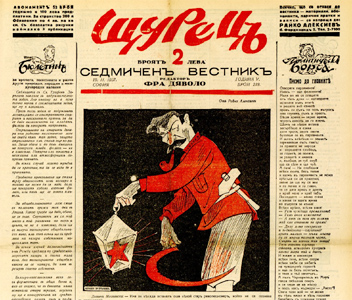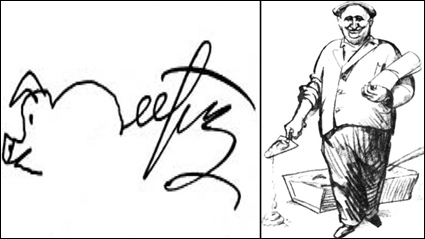The bloody drama with the Charlie Hebdo French satirical weekly magazine made writer Rossen Tahov take us back to the history of Bulgarian satire cartoons.
 “It began even before the 1878 Liberation with the first cartoonist, related to Bulgaria", Rossen Tahov said. "He was Polish emigrant to Wallachia Henryk Dembitski (1830-1906), a friend of revolutionary poet and publicist Hristo Botev. He drew the caricatures for the Budilnik (Alarm-Clock) and Tupan (Drum) newspapers that were released in what’s today Romania. It has been proven that Botev gave the ideas for the cartoons. In 1868 Dembitski drew in a satirical manner the official stepping into office of the new Turkish governor in Ruschuk, or Russe nowadays. The Danube River could be spotted in the background, with a steamship – Radetzky sailing there. In my opinion, and I discovered this twenty years ago, Botev had singled out that vessel nearly 10 years before its fatal taking and the whole epic story that followed.”
“It began even before the 1878 Liberation with the first cartoonist, related to Bulgaria", Rossen Tahov said. "He was Polish emigrant to Wallachia Henryk Dembitski (1830-1906), a friend of revolutionary poet and publicist Hristo Botev. He drew the caricatures for the Budilnik (Alarm-Clock) and Tupan (Drum) newspapers that were released in what’s today Romania. It has been proven that Botev gave the ideas for the cartoons. In 1868 Dembitski drew in a satirical manner the official stepping into office of the new Turkish governor in Ruschuk, or Russe nowadays. The Danube River could be spotted in the background, with a steamship – Radetzky sailing there. In my opinion, and I discovered this twenty years ago, Botev had singled out that vessel nearly 10 years before its fatal taking and the whole epic story that followed.”
“Our cartoonists used to be persecuted, beaten and sentenced in both periods – the monarchy up to 1944 and during the communist regime 1944 – 1989,” Rossen Tahov goes on to say. The Balkanska Tribuna (Balkan Tribune) newspaper was at war with the personal regime of Tsar Ferdinand in the beginning of the 20th century. The cartoons of Ivan Slavov were also disturbing to the royal entourage and the respective measures followed. “On January 19,” journalist Georgi Nikolov writes, “at 11:30 pm Ivan Slavov stepped out of the city casino. At what’s now Bulgarian Commercial Bank he was captured by three individuals with sticks, who would beat him severely due to his cartoons, injuring heavily his head. The man was then taken to a hospital.”
“Alexander Bozhinov was the first master of Bulgaria caricature,” Rossen Tahov goes on to say. “I feel real pity for that person, as I live in a neighborhood with a small street, named after him – it is only 21 m long. Alexandar Bozhinov was like a patriarch in his area – there was not a single historical event which was not reflected by his curved mirror. That was why the People’s Court sent him to prison for one year in 1945. The judges were generous and the sentence remained suspended. Thus they sentenced Alexander Dobrinov, who did time in jail both before 9 September 1944 and afterwards. In 1925, a few months before the assault at the St. Nedelya Church downtown Sofia the artist turned into a prophet, drawing it in flames and with the inscription: ‘Jesus won’t resurrect this year’.”
Cartoonist Raiko Aleksiev was a remarkable person who used to be a taboo before the 1989 democratic changes. Rossen Tahov was the first journalist to ask the question across printed editions officially: “Who murdered Raiko Aleksiev?” “His wife was still alive and she lived in Vienna. We met and she gave me the details,” the writer recalls.
 “He was beaten to death right after September 9, 1944 (the socialist coup). It was rather a personal revenge,” Rossen Tahov goes on to say. “This person deserves to have his place in Bulgarian cultural history. The legendary Shturets (Cricket) newspaper with his last edition on 8 September 1944 was not Alexiev’s only contribution. He also created the Baraban /Drum/ newspaper, where in my opinion he draw the first caricatures of Lenin – that was one of the reasons why he got beaten to death. He used to laugh at Stalin as well, but also at Hitler. He was arrested on his way out of a pastry shop and closed up in what was then the School of Blind People, then he was moved to the Red Cross hospital, but after two weeks of torture he had no chances and passed away. That is what I know from his wife.”
“He was beaten to death right after September 9, 1944 (the socialist coup). It was rather a personal revenge,” Rossen Tahov goes on to say. “This person deserves to have his place in Bulgarian cultural history. The legendary Shturets (Cricket) newspaper with his last edition on 8 September 1944 was not Alexiev’s only contribution. He also created the Baraban /Drum/ newspaper, where in my opinion he draw the first caricatures of Lenin – that was one of the reasons why he got beaten to death. He used to laugh at Stalin as well, but also at Hitler. He was arrested on his way out of a pastry shop and closed up in what was then the School of Blind People, then he was moved to the Red Cross hospital, but after two weeks of torture he had no chances and passed away. That is what I know from his wife.”
 In the communist period there was an emblematic case with the Liuti Chushki (Chilly Peppers) compilation in 1968, Rossen Tahov recalls. The epigrams of Radoy Rallin and the illustrations of Boris Dimovski were published there. The sacral signature of communist dictator Todor Zhivkov was twisted, resembling a pig’s tail. After a letter of cautious “literary” experts the book was burnt in the fireboxes by the People’s Militia, while the authors got their punishments. Todor Tsonev was the last Bulgarian cartoonist who did time in jail. He had created hundreds of caricatures of leader Todor Zhivkov. In 1979 State Security searched the house of the artist and he found himself in jail. After the democratic changes Zhivkov saw the cartoons for a first time, but only laughed at them.
In the communist period there was an emblematic case with the Liuti Chushki (Chilly Peppers) compilation in 1968, Rossen Tahov recalls. The epigrams of Radoy Rallin and the illustrations of Boris Dimovski were published there. The sacral signature of communist dictator Todor Zhivkov was twisted, resembling a pig’s tail. After a letter of cautious “literary” experts the book was burnt in the fireboxes by the People’s Militia, while the authors got their punishments. Todor Tsonev was the last Bulgarian cartoonist who did time in jail. He had created hundreds of caricatures of leader Todor Zhivkov. In 1979 State Security searched the house of the artist and he found himself in jail. After the democratic changes Zhivkov saw the cartoons for a first time, but only laughed at them.
English version: Zhivko Stanchev
The history of the largest Bulgarian church in Bulgaria from the National Revival period "The Assumption of the Virgin Mary" in the town of Pazardzhik is long and interesting. It is assumed that the first church there was built in the 17th century. It..
On 10 August 1915, the first Bulgarian-built aeroplane took to the skies for a test flight in Bozhurishte. It was designed by inventor Assen Yordanov, whose name still features in the textbooks used to train pilots and engineers today. From an early..
A trilingual exhibition titled “Egyptian Cults around the Black Sea” opens today at 6 PM at the Archaeological Museum in Sozopol , according to BNR – Burgas. Part of an international research project, the exhibition is organized by the Institute of..

+359 2 9336 661
